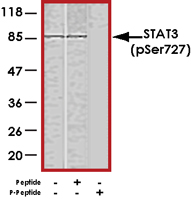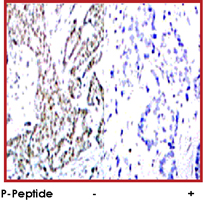
Anti-phospho-STAT3 (Ser727)
Rabbit Polyclonal Antibody
Catalog No. S54-365BR
| Catalog No. | Pack Size | Price (USD) | |
|---|---|---|---|
| S54-365BR-100 | 100 ug | $325 | |
| S54-365BR-BULK | BULK | Contact Us |

Rabbit Polyclonal Antibody
Catalog No. S54-365BR
| Catalog No. | Pack Size | Price (USD) | |
|---|---|---|---|
| S54-365BR-100 | 100 ug | $325 | |
| S54-365BR-BULK | BULK | Contact Us |
Overview:
STAT3 is a member of the signal transducers and activators of transcription (STAT) family of proteins that carry out dual functions. STAT3 is a DNA binding protein that is widely expressed and becomes activated upon phosphorylation on Tyr708, which leads dimerization, intracellular translocation and DNA-binding. Phosphorylation at Ser727 regulates transcriptional activity. STAT3 is activated in response to variety of stimuli, which includes EGF, IL-6, PDGF, IL-2 and G-CSF (1). STAT3 forms homo- and hetero-dimers with other STAT proteins to modulate the transcription of various genes (2).
References:
1. Zhong, Z. et al: Stat3: a STAT family member activated by tyrosine phosphorylation in response to epidermal growth factor and interleukin-6. Science. 1994 Apr 1;264(5155):95-8.
2. Tian, S. S. et al: Rapid activation of the STAT3 transcription factor by granulocyte colony-stimulating factor. Blood. 1994 Sep 15;84(6):1760.
Specificity:
Recognizes the GS3 beta protein phosphorylated at serine 727
Cross Reactivity:
Human, Mouse and Rat
Host / Isotype / Clone#:
Rabbit, IgG
Immunogen:
Synthetic phospho-peptide corresponding to amino acid residues surrounding Ser727
Purification:
Affinity chromatography
Stability:
Store at 4oC (add 0.1% NaN3) for several months, and at -20oC for longer periods. For optimal storage, aliquot target into smaller quantities after centrifugation and store at recommended temperature. For most favorable performance, avoid repeated handling and multiple freeze/thaw cycles.
Sample Data:
Western blots from HeLa cells using anti-phospho- phospho-STAT3 (Ser727) antibody.

|
Sample Data:
Immunohistochemical analysis of paraffin-embedded human breast carcinoma tissue using anti-phospho-STAT3 (Ser727) antibody.

|
![]() Yamamoto Masahiro et al., A single polymorphic amino acid on Toxoplasma gondii kinase ROP16 determines the direct and strain-specific activation of Stat3 Journal of Experimental Medicine November 2009 10.1084/jem.20091703
Yamamoto Masahiro et al., A single polymorphic amino acid on Toxoplasma gondii kinase ROP16 determines the direct and strain-specific activation of Stat3 Journal of Experimental Medicine November 2009 10.1084/jem.20091703
![]() K. Urlam Murali et al., Development of new N-arylbenzamides as STAT3 dimerization inhibitors Medicinal Chemistry Communication April 2013 10.1039/C3MD20323A
K. Urlam Murali et al., Development of new N-arylbenzamides as STAT3 dimerization inhibitors Medicinal Chemistry Communication April 2013 10.1039/C3MD20323A
![]() Kim Daejin et al., A specific STAT3-binding peptide exerts anti-proliferative effects and antitumor activity by inhibiting STAT3 phosphorylation and signaling Cancer Research February 2014 10.1158/0008-5472.CAN-13-2187
Kim Daejin et al., A specific STAT3-binding peptide exerts anti-proliferative effects and antitumor activity by inhibiting STAT3 phosphorylation and signaling Cancer Research February 2014 10.1158/0008-5472.CAN-13-2187
![]() Zhang Xiaolei et al., A novel inhibitor of STAT3 homodimerization selectively suppresses STAT3 activity and malignant transformation Cancer Research January 2013 10.1158/0008-5472.CAN-12-3175
Zhang Xiaolei et al., A novel inhibitor of STAT3 homodimerization selectively suppresses STAT3 activity and malignant transformation Cancer Research January 2013 10.1158/0008-5472.CAN-12-3175
![]() Li Zhi et al., Two Rare Disease-Associated Tyk2 Variants Are Catalytically Impaired but Signaling Competent Journal of Immunology March 2013 10.4049/jimmunol.1203118
Li Zhi et al., Two Rare Disease-Associated Tyk2 Variants Are Catalytically Impaired but Signaling Competent Journal of Immunology March 2013 10.4049/jimmunol.1203118
![]() Jin Jeon Young et al., Role of NEK6 in Tumor Promoter-induced Transformation in JB6 C141 Mouse Skin Epidermal Cells Journal of Biological Chemistry September 2010 10.1074/jbc.M110.137190
Jin Jeon Young et al., Role of NEK6 in Tumor Promoter-induced Transformation in JB6 C141 Mouse Skin Epidermal Cells Journal of Biological Chemistry September 2010 10.1074/jbc.M110.137190
![]() CC Arpin et al., Applying Small Molecule Signal Transducer and Activator of Transcription-3 (STAT3) Protein Inhibitors as Pancreatic Cancer Therapeutics Molecular Cancer Therapeutics May 2016 10.1158/1535-7163.MCT-15-0003
CC Arpin et al., Applying Small Molecule Signal Transducer and Activator of Transcription-3 (STAT3) Protein Inhibitors as Pancreatic Cancer Therapeutics Molecular Cancer Therapeutics May 2016 10.1158/1535-7163.MCT-15-0003
![]() Mazouchia Amir et al., On the performance of bioanalytical fluorescence correlation spectroscopy measurements in a multiparameter photon-counting microscope Analytica Chimica Acta February 2011 10.1016/j.aca.2011.01.002
Mazouchia Amir et al., On the performance of bioanalytical fluorescence correlation spectroscopy measurements in a multiparameter photon-counting microscope Analytica Chimica Acta February 2011 10.1016/j.aca.2011.01.002
![]() A. Cumaraswamy Abbarna et al., Nanomolar-Potency Small Molecule Inhibitor of STAT5 Protein ACS Medical Chemistry Letters September 2014 10.1021/ml500165r
A. Cumaraswamy Abbarna et al., Nanomolar-Potency Small Molecule Inhibitor of STAT5 Protein ACS Medical Chemistry Letters September 2014 10.1021/ml500165r
![]() Giri Shailendra et al., Preclinical Therapeutic Potential of a Nitrosylating Agent in the Treatment of Ovarian Cancer PLoS One June 2014 10.1371/journal.pone.0097897
Giri Shailendra et al., Preclinical Therapeutic Potential of a Nitrosylating Agent in the Treatment of Ovarian Cancer PLoS One June 2014 10.1371/journal.pone.0097897
![]() Kinoshita Takayoshi et al., Knowledge-Based Identification of the ERK2/STAT3 Signal Pathway as a Therapeutic Target for Type 2 Diabetes and Drug Discovery Chemical Biology & Drug Design July 2011 10.1111/j.1747-0285.2011.01151.x
Kinoshita Takayoshi et al., Knowledge-Based Identification of the ERK2/STAT3 Signal Pathway as a Therapeutic Target for Type 2 Diabetes and Drug Discovery Chemical Biology & Drug Design July 2011 10.1111/j.1747-0285.2011.01151.x
![]() Zeidan N et al., Magnetic bead-based electrochemical detection of interaction between epigallocatechin-3-gallate and STAT proteins Analytical Methods March 2015 10.1039/c5ay00169b
Zeidan N et al., Magnetic bead-based electrochemical detection of interaction between epigallocatechin-3-gallate and STAT proteins Analytical Methods March 2015 10.1039/c5ay00169b
![]() Salvatore Badali Daniel et al., Development of STAT3 as an accessible target for fluorescence-based inhibition assays Journal of Undergraduate Life Sciences May 2010
Salvatore Badali Daniel et al., Development of STAT3 as an accessible target for fluorescence-based inhibition assays Journal of Undergraduate Life Sciences May 2010
![]() Danielle Croucher et al., Targeting the STAT3 signaling pathway in cancer: role of synthetic and natural inhibitors. Thesis; University of Toronto July 2013 10.1016/j.bbcan.2013.12.005
Danielle Croucher et al., Targeting the STAT3 signaling pathway in cancer: role of synthetic and natural inhibitors. Thesis; University of Toronto July 2013 10.1016/j.bbcan.2013.12.005
Apoptosis/Autophagy, Cancer, ERK/MAPK Pathway, Inflammation, JAK/STAT Pathway
STAY CONNECTED
Fax: 1-604-232-4601